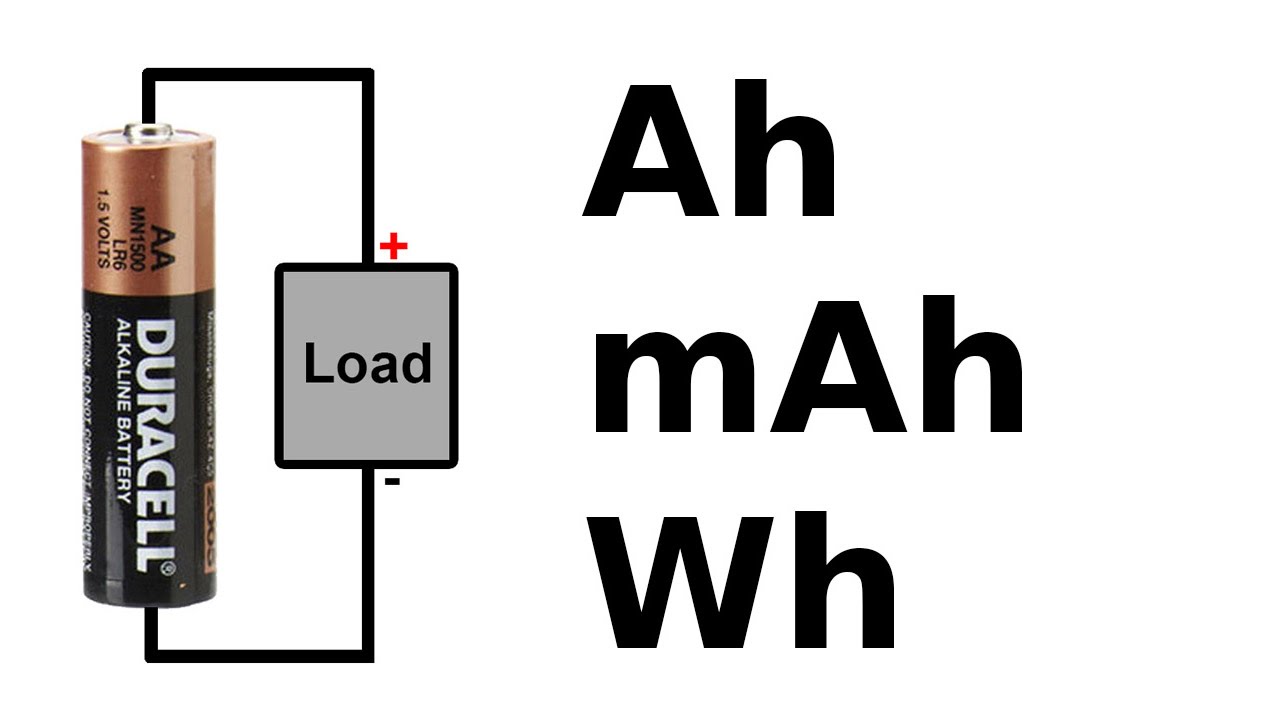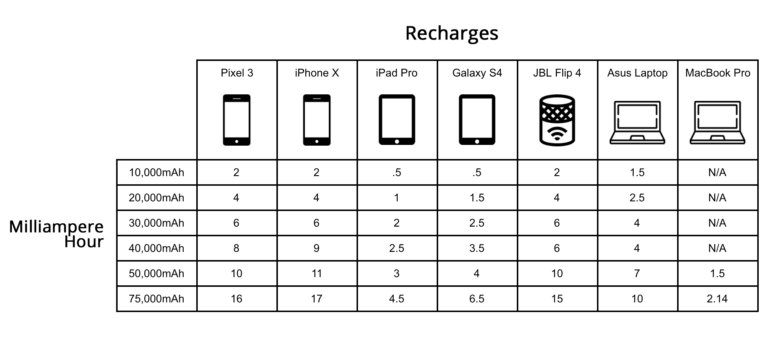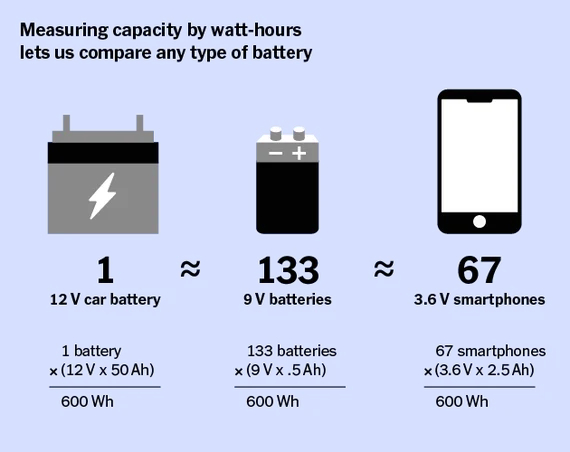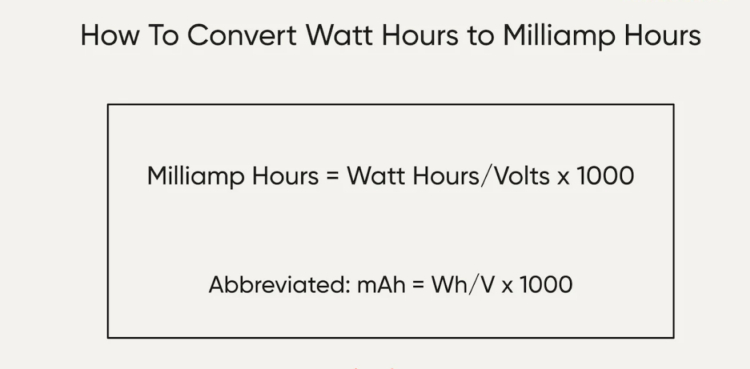Introduction to mAh: mAh (milliampere-hour) is a unit of measurement commonly used to describe the capacity of a battery. It indicates how much charge a battery can hold and how long it can power a device before needing recharging. Understanding mAh is crucial when choosing batteries for electronic devices, as it directly affects their runtime and performance.

Key Concepts:
-
Definition:
- mAh represents the amount of current a battery can deliver over one hour. For example, a 2000mAh battery can supply 2000 milliamperes (2 amperes) per hour.
-
Relation to Capacity:
- Higher mAh ratings generally indicate a higher capacity battery, capable of providing more power for a longer duration.
-
Capacity vs. Size:
- Larger batteries (physically) typically have higher mAh ratings, offering greater energy storage.
-
Battery Life:
- The mAh rating directly impacts a device's battery life. A higher mAh battery will last longer before requiring recharging.
-
Device Compatibility:
- Ensure that the replacement battery for a device matches or exceeds the original mAh rating for optimal performance.
Calculating Battery Life:
-
Formula:
- Battery Life (hours) = Battery Capacity (mAh) / Device Consumption Rate (mA)
- This formula estimates how long a battery can power a device based on its current consumption rate.
-
Example:
- A device consumes 100mA of current. A 2000mAh battery would theoretically power it for 2000mAh / 100mA = 20 hours.
Practical Considerations:
-
Real-world Variables:
- Factors like temperature, discharge rate, and internal resistance can affect actual battery life compared to theoretical calculations.
-
Battery Degradation:
- Over time and usage, battery capacity diminishes. Rechargeable batteries eventually lose some of their original capacity.
-
mAh Ratings for Comparisons:
- Use mAh ratings when comparing similar battery types across different brands or models.
Applications:
-
Consumer Electronics:
- Smartphones, laptops, cameras, and portable devices utilize batteries with varying mAh capacities.
-
Electric Vehicles:
- EVs use high-capacity batteries measured in kilowatt-hours (kWh), which are equivalent to 1000s of mAh.
-
Power Banks:
- Power banks, designed to recharge portable devices, come in various mAh capacities to cater to different charging needs.
Conclusion:
Understanding mAh is essential for effectively managing battery-powered devices. By grasping the basics of mAh ratings, consumers can make informed decisions when selecting batteries, maximizing device runtime, and ensuring reliable power sources for various electronic applications.

Detailed Answer: What Does MAH Stand for
"M" stands for "milli," which is a prefix denoting one-thousandth of a unit in the metric system. "A" stands for "ampere," which is the unit of electrical current. "H" stands for "hour," a unit of time.
mAh stands for milliampere-hour. It is a unit of measurement used to quantify the capacity of a battery by indicating how much electrical charge it can deliver over time. The "milliampere-hour" unit combines "milliamperes," a measure of electric current, with "hours," a measure of time, to represent the total amount of charge a battery can hold and deliver. This measurement is crucial in understanding how long a battery can power a device before needing recharging.
Key Concepts of MAH: Building Blocks for Beginners
1. Milliampere-hour (mAh)
-
Definition: mAh is a unit of electrical charge commonly used to measure the capacity of a battery.
-
Basic Idea: Represents the total charge a battery can deliver over one hour when the current flow is maintained at a rate of one milliampere (mA).
2. Capacity and Duration
-
Capacity: Indicates the energy storage capability of a battery.
-
Relation to Duration: Higher mAh ratings typically mean a battery can power a device for a longer period before needing to be recharged.
3. Power and Energy
-
Power vs. Energy: Power is the rate at which energy is transferred or converted. Energy is the capacity to do work.
-
mAh in this Context: mAh represents the energy capacity of a battery, which determines how much work it can do.
4. Device Compatibility
-
Matching Requirements: Selecting a battery with mAh ratings that match or exceed the device's requirements is essential for optimal performance.
-
Overcapacity: Choosing a battery with significantly higher mAh ratings may not always result in better performance.
5. Consumption Rate and Battery Life
-
Relationship: Battery Life (hours) = Battery Capacity (mAh) / Device Consumption Rate (mA)
-
Calculating Duration: Dividing the battery's capacity in mAh by the device's current consumption rate estimates how long the battery can power the device.
6. Real-world Factors
- Variability: Factors like temperature, discharge current, and age impact a battery's actual performance compared to theoretical calculations.
7. Practical Applications
-
Consumer Electronics: Smartphones, laptops, cameras, and other portable devices utilize batteries with varying mAh capacities.
-
Electric Vehicles: EVs use high-capacity batteries typically measured in kilowatt-hours (kWh), equivalent to thousands of mAh.
8. Comparisons and Decision-making
-
Battery Selection: Comparing mAh ratings across different battery types helps in selecting the most suitable power source for specific applications.
-
Optimizing Usage: Understanding mAh enables users to make informed decisions to optimize battery usage and device performance.
Conclusion
By grasping these fundamental concepts of mAh, beginners can develop a solid foundation for understanding battery capacities, energy storage, and the relationship between mAh ratings and device performance. This knowledge is essential for effectively managing battery-powered devices and making informed choices when selecting batteries for various electronic applications.
Practical Examples: Illustrating its Usage in Everyday Scenarios

1. Smartphones
-
Scenario: Consider two smartphones—one with a 3,000 mAh battery and another with a 4,500 mAh battery.
-
Usage Example: If both phones have similar power consumption rates, the device with a 4,500 mAh battery will likely offer longer battery life before needing a recharge compared to the 3,000 mAh battery phone.
2. Power Banks
-
Scenario: You have a 10,000 mAh power bank.
-
Usage Example: Understanding that the power bank has a capacity of 10,000 mAh helps estimate how many times it can recharge a device with a known battery capacity. For instance, a phone with a 3,000 mAh battery might be charged approximately three times from this power bank.
3. Flashlights
-
Scenario: Comparing two flashlights, one powered by two AA batteries rated at 1,500 mAh and the other by a rechargeable battery with 2,000 mAh capacity.
-
Usage Example: The flashlight with the 2,000 mAh rechargeable battery might provide longer usage time before requiring recharging compared to the one using standard AA batteries with a total capacity of 3,000 mAh.
4. Wireless Speakers
-
Scenario: Different wireless speakers with varying battery capacities—say, 2,500 mAh and 4,000 mAh.
-
Usage Example: The speaker with a 4,000 mAh battery can potentially play music for a longer duration on a single charge compared to the one with a 2,500 mAh battery at similar volume levels and usage patterns.
5. Digital Cameras
-
Scenario: Two digital cameras with battery capacities of 1,200 mAh and 2,500 mAh.
-
Usage Example: The camera equipped with a 2,500 mAh battery will likely allow for more photos to be taken or longer video recording sessions before needing a recharge compared to the camera with the 1,200 mAh battery.
6. Electric Toothbrushes
-
Scenario: Comparing electric toothbrushes—1,500 mAh and 2,000 mAh battery capacities.
-
Usage Example: The electric toothbrush with a 2,000 mAh battery may last longer between charges compared to the one with a 1,500 mAh capacity, offering extended usage before needing to recharge.
Conclusion
Understanding mAh in these everyday scenarios provides practical insights into how battery capacities impact device performance, usage durations, and the need for recharging. By considering mAh ratings when selecting or using devices and batteries, individuals can make informed decisions to optimize the efficiency and longevity of battery-powered devices in their daily lives.

Is A Higher MAH Battery Better
When evaluating whether a higher mAh battery is better, it's essential to consider several factors to determine what suits your needs best. Here are key points to help you decide:
Pros of Higher mAh Batteries
-
Longer Battery Life: Higher mAh batteries typically provide longer runtimes before requiring a recharge. This can be beneficial for devices that are used extensively or require prolonged usage without access to charging.
-
Convenience: With a higher mAh capacity, you may not need to recharge your device as frequently, offering more convenience, especially in situations where access to charging outlets is limited.
-
Suitable for Power-Hungry Devices: Devices that consume a lot of power, such as modern smartphones or tablets, can benefit from higher mAh batteries to ensure they stay powered for longer periods.
Cons of Higher mAh Batteries
-
Increased Weight and Size: Higher mAh batteries often come in larger sizes and have more weight, which can affect the portability and overall design of the device.
-
Cost: Batteries with higher mAh ratings may be more expensive than lower capacity ones, impacting the overall cost of the device or replacement batteries.
-
Overkill for Some Devices: For devices with low power requirements or infrequent use, opting for a significantly higher mAh battery may not always be necessary, leading to added weight and bulk without significant benefits.
Considerations for Choosing the Right Battery
-
Device Usage: Assess how you use the device. If you need extended battery life, a higher mAh battery might be beneficial. However, for devices with sporadic use, a lower capacity battery might suffice.
-
Portability: If portability is crucial, consider whether the added weight and size of a higher mAh battery will impact the device's usability or your comfort in carrying it.
-
Compatibility: Ensure that the battery with a higher mAh rating is compatible with your device. It is essential to follow the manufacturer's recommendations to prevent damage or performance issues.
-
Balancing Factors: Balance your priorities between battery life, device weight, cost, and other factors to determine the optimal mAh rating for your needs.
Conclusion
While higher mAh batteries offer extended battery life, they come with trade-offs such as increased weight, size, and cost. Whether a higher mAh battery is better depends on your specific requirements and priorities. It's essential to consider how you use your device, the balance between battery life and other factors, and choose a battery that aligns with your needs for optimal performance and convenience.



